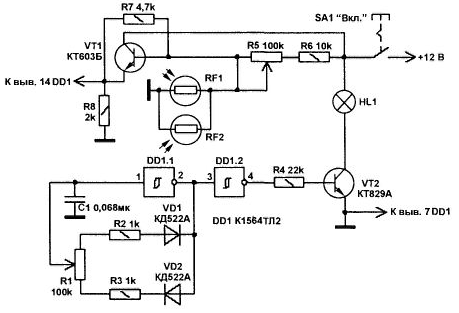According to the Rules of the road, at dusk, the driver must to turn the Parking lights of the vehicle. Like, just, but why be distracted in while driving, if this work can instruct automation.
The proposed scheme monitors light levels and when the preset threshold includes "dimensions".

The light sensors are photoresistors RF1 and RF2 (two, United in parallel to improve sensitivity) transistor key VT1. The sensitivity of the node is adjusted by the variable resistor R5. When the increase in its resistance, the sensitivity decreases. When the external illumination sufficient (street light), the resistance of the photoresistor little (some of the shortfall), and the transistor VT1 is closed, DD1 chip is de-energized.
When darkness falls, the resistance RF1 increases, and at some point transistor VT1 opens. On DD1 chip is powered, runs the pulse generator on the element DD1.1 (DD1.2 - buffer), managing transistor key VT2. The key switches the lamp "dimensions" (the diagram shows one - HL1). By changing the duty cycle of the pulse generator is adjustable brightness the lamps. The duty cycle is set by the variable resistor R1 (preferably to apply Luts) and is modified so that supplied to the load power varies in the range of 5 to 95%.
The device incorporates a chip CTL, each element of which is an inverter with Schmitt trigger input. The chip contains four the same type of element. The transfer characteristic of the Schmitt trigger has two different threshold (activation and release), i.e. has a hysteresis. Voltage hysteresis for Ur given chip is proportional to the voltage power. So, if Un=12 V, Ur=2.4 V. the voltage Fluctuations that are included in this limit, the Schmitt trigger ignores. Therefore, the chip is convenient for CTL build noise-generators and pulse shapers different purpose.
Powerful composite transistor CTA can be replaced by CT(B...G), CT (...), CT (...), CTA. CTA, CTB, CTA, CTB. Transistor VT1 can replace CT, CT, CT, CT, KT815 with any letter index. Photoresistors RF1 and RF2 - PPS-2. Instead, you can use any photoresistors from the PPS. FR, FR. All fixed resistors - MLT-0,25. Capacitor C1 - km-6. Diodes VD1, VD2 can be replaced by CDB.
The transistor VT2 should be installed on a heat sink with a cooling area of not less than 60 cm2. In operation, the transistor is normally heated to a temperature of 40...50°C.
The elements are mounted on the breadboard, the findings are connected with a jumper from wire MGTF-0.8 mm. Ready the device is placed in the appropriate box (bar of soap), which is attached under the dashboard and is connected to the side network car (12 V) through any compact connector, for example, RP-5. Handles adjust variable resistors must be accessible for adjustment sensitivity and changes the brightness of the bulbs if necessary.
This device can be used for fine adjustment of illumination of salon car or to adjust the brightness of the dashboard lights.
Author: A. Kashkarov, St.-Petersburg






